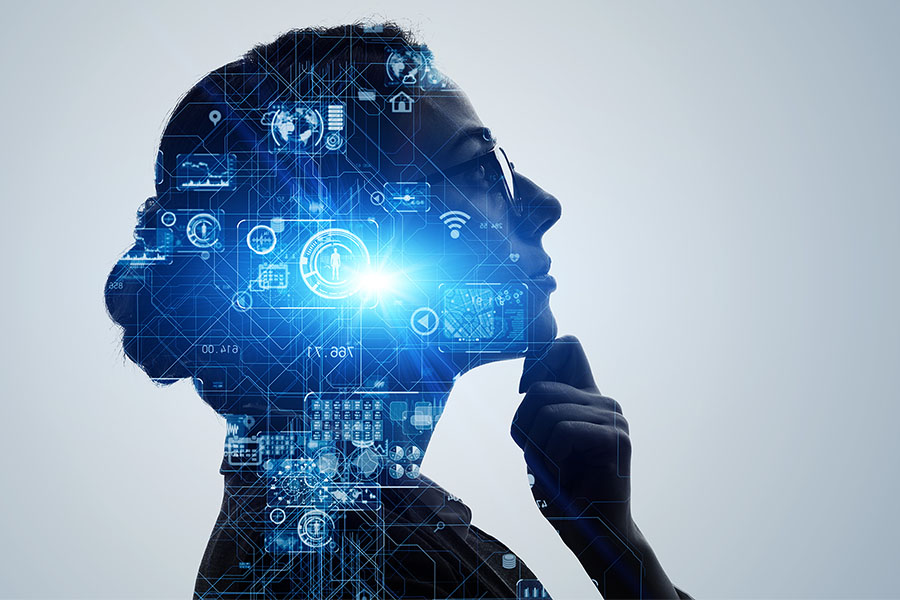
Thinking about AI.
Pondering the future of AI and Machine Learning
Experts discuss impacts of technology at Extended Education lifelong learning webinar
Harnessing the power of Artificial Intelligence is about more than understanding the technical aspects. It is also critical to use it strategically.
“In business, most AI projects fail. I see a lot of challenges now. The technology is important, but it is even more important to understand how it can affect business outcomes. We need to know what we want and how we can get there,” said Briana Brownell of Pure Strategy, one of three speakers at Extended Education’s Rise of the Machine Age: Act II webinar on Nov. 18. Brownell is also a content provider for Extended Education’s new Artificial Intelligence: Machine Learning Solutions program.
Strategic approach
Jason Shields, Assistant Professor, Interior Design, agreed. “We need to understand what we want. We have to use the tools accurately.” Shields is also a consultant on Extended Education’s upcoming Building Information Modeling program.
Kari Kumar, Associate Dean (Academic), Extended Education noted that the role of a university is not changing. It is still to develop a skilled workforce and a critical society. “We want our grads to be both skilled and critically reflective,” Kumar said.
Extended Education Acting Dean, Rod Lastra moderated the discussion. Lastra set the stage by reminding us how when the machine age arrived 250 years ago, it changed everything – supplanting metabolic energy with steam power. And now, with the second machine age, he says, “Human cognitive power is being extended by machines, and it is hard to understand what the immediate future will hold.”
To make us more human
Brownell challenged stereotypical assumptions about AI. “My mom still thinks I develop killer robots but I want to challenge that. We need to think about ways AI can make us more human, not less human.”
She started her career in data science and Machine Learning 15 years ago. “Things were exciting back then and now we are seeing faster developments and new capabilities. AI can do things we once thought were exclusively the domain of humans.”
For example, she says, people doubted AI could play chess, but as soon as it could do so competitively, she says, “We moved the goal posts. AI created art and music. We moved the goal posts again. AI is encroaching on the domains of humans. This is the perfect moment to think of what we want the future to be. I am excited to see where it goes.”
Shields says technology has changed how industry and research works. For example, he says, “Design programs can now relay a 3-D virtual reality so we can engage with a space not yet created. Integrated mixed reality headsets overlay digital information on reality. I can walk around with a device on my chest, scanning in every direction.”
Design has gone from sketching to AutoCAD to Building Information Modeling, allowing for a holistic approach to design. “I am looking forward to seeing 3-D environments generated. Of course, we have to understand the fundamentals before we use the tools. We will use AI to augment our previous existing knowledge.”
Responding to the skills gap
In university continuing education and lifelong learning, it is essential to respond to the skills gap, says Kumar. “We are synergists. We try to create conditions for synergy to happen, with our expertise and subject matter experts.”
For education providers, creativity and innovation are very important, she says. “It’s essential to respond to the skills gap, which has been exasperated by digital transformation. It’s important to weave new tech skills and human-focused skills into our programming, to provide access to learners with programming including shorter, micro-credentials (like our AI program).”
In design, Shields says people did not want AI at first but now they realize its strengths. For example, using BIM to build and share models with stakeholders conveniently brings them together in a virtual space, reducing their carbon footprint. Machine Learning for material selection provides data to look at materials used and understand the impact on forestry, for example. Physical building sensors can tell a digital model what is happening, gathering appropriate data before a person is sent in to respond. Mixed reality can offer a disabled person access to engage in a space they could not access physically.
We must remain adaptable, flexible and competitive for the future, says Kumar. At the university, data can be a strategic asset. Learning management systems, multi-media tools, synchronous and collaborative technology are here and new and exciting things are likely to come. “AI can help us to better understand how students are engaging with materials, support adaptive learning, and detect plagiarism. It would have been great to have it when I taught anatomy and physiology.”
With technology comes responsibility, she adds. “Let’s be very careful to create equitable learning opportunities, not creating barriers for some.”






